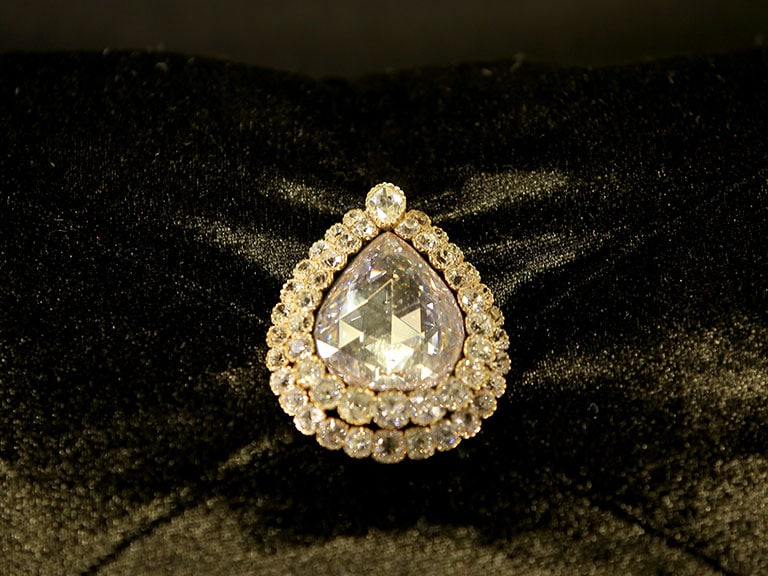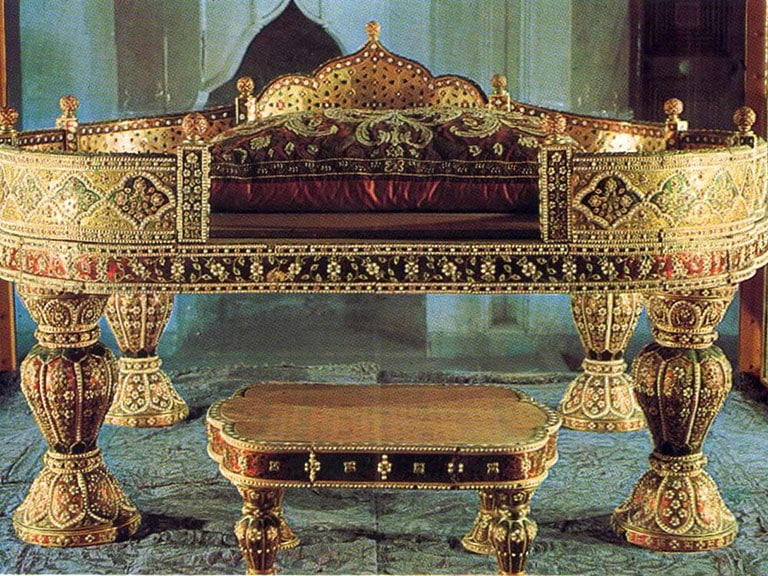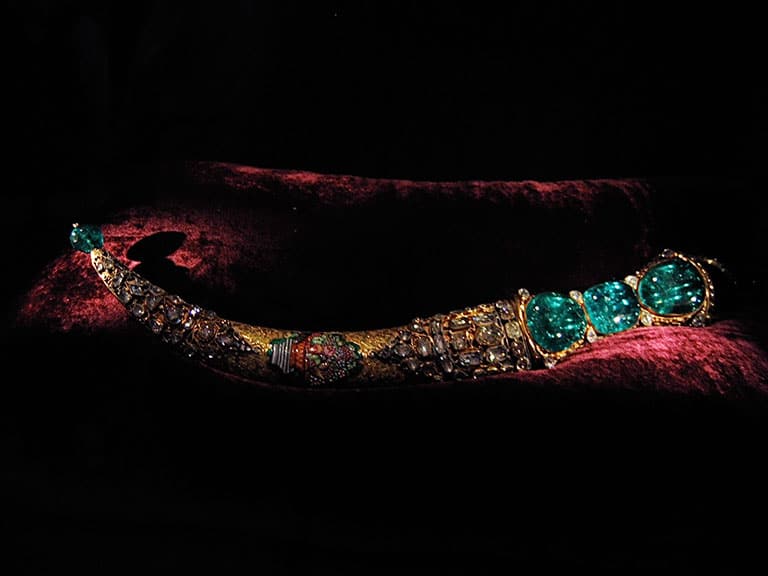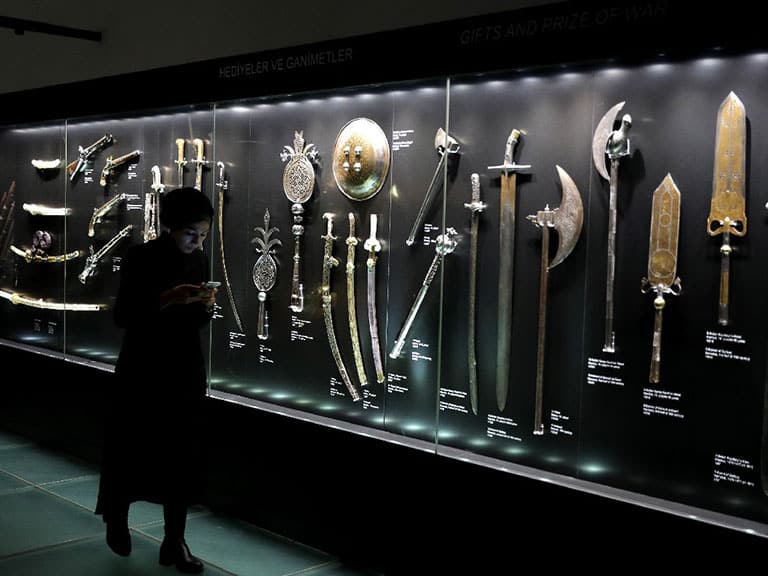The Ottoman Imperial Treasury was legendary in the past, and today its remarkable collections of thousands of rare and beautiful objects continue to dazzle visitors to Topkapi Palace.
The Treasury is housed in four rooms in the third court of Topkapi Palace, built by Sultan Mehmed II (1451-1481). The earliest records concerning the Treasury are inventory lists of three to five pages dating from the reigns of Mehmed II and Bayezid II (1481-1512). Treasury registers kept in later periods provide further, if limited, information about the contents of the Treasury.
The organization of the Inner Palace consisted of various corps of staff, the treasurers being one of the most important. During the reign of Mehmed II, the number of treasurers appears to have been small, rising to 60 during the reign of Ahmed I (1603-1617) and to 157 during the reign of Ahmed III (1703-1730).
Opening the Imperial Treasury was an affair of the strict ceremony. The Steward of the Treasury would bring the keys and then check the seal as ordained by Selim I (1512-1520) following his campaigns against Iran and Egypt in 1514 and 1517, respectively, before unlocking the doors. This formality was followed by the wishes of Selim I until Topkapi Palace became a museum in 1924.
Today, the Treasury is both opened and closed by a group of authorized staff. The building which housed the precious objects and bullion belonging to the Ottoman sultans is today used to exhibit only jeweled and gold items. Still, originally the contents of the Palace Treasury were far broader in scope, including precious manuscripts and albums, fabrics, royal clothing, embroideries, silverware, porcelain, calligraphic tools, seals, weapons, clocks, and documents. When the palace became a museum, these were transferred to the appropriate sections.
The Treasury grew over the centuries with the addition of spoils of war and gifts from foreign rulers and Ottoman politicians. On such occasions as religious feast days, the enthronement of a new sultan, and celebrations of royal circumcisions or weddings, the country’s most eminent craftsmen would present the sultan finest masterpieces.

Spoonmaker’s Diamond
Besides, many objects were purchased, the most celebrated being the 86 carat Kasikci Elmasi (Spoonmaker’s Diamond), which was discovered on a rubbish dump in the Egrikapi district of Istanbul during the reign of Mehmed IV (1648-1687). The chief imperial jeweler purchased the diamond, and it was placed in the Treasury.
Every year the Ottoman sultans sent gifts of money and precious objects to Mecca and Medina. These objects were returned to Topkapi Palace for safekeeping during the First World War by Governor of the Hejaz Fahreddin Pasa. Today they form an essential group in the Treasury collections.
Another group of objects consists of those brought to the Treasury from the palaces of Dolmabahce and Yildiz following the proclamation of the Turkish Republic in 1923. The contents of the Treasury were always stored in chests and cupboards until the reign of Sultan Abdulmecid (1839-1861) when for the first time, some of these precious objects were placed on display.
Although the majority of items date from the 16th-19th centuries, there are also pieces of Byzantine, Mamluk, and Seljuk origin, such as the gold reliquaries containing the occiput, arm, and the hand of John the Baptist, a 14th century Mamluk glass lamp, a 13th century Seljuk steel mirror bearing the figure of a horseman, and a 15th-century sandalwood chest belonging to Ulugh Bey, the grandson of Timur.

The Golden Thrones
Royal thrones are exhibited in each of the four Treasury rooms. The 16th-century ebony throne is in the classical Ottoman throne form and inlaid with ivory and mother of pearl in split-leaf scrolls and cintemani (three-spot) motifs. It is thought to have been used by Murad IV (1623-1640) during the Baghdad campaign.
The gold throne was used by the Ottoman sultans until the collapse of the empire. It is made of wood covered entirely with gold plate and mounted with 954 large chrysolites in lobed gold mounts. The throne was presented to Murad III (1574-1595) by Governor of Egypt, Ibrahim Pasa.
The throne of Ahmed I (1603-1617) is a masterpiece of the mother of pearl and tortoiseshell inlay on walnut and is set with precious gems. This baldachin style throne is inscribed with the name of Sultan Ahmed I inside the canopy.
The fourth throne was the gift of Nadir Shah of Iran to Mahmud I (1730-1754). Made in India, the throne is gold plated with enameled decoration studded with thousands of pearls, rubies, and emeralds.
Jeweled pendants were hung as symbols of royalty from throne canopies and the domes, ceilings, and doorways of the rooms used by the sultan. Among those in the collection are emerald pendants made for Ahmed I, Mustafa III (1757-1774), Abdulhamid I (1774-1789), and Abdulmecid (1839-1861), and enameled silver pendants mounted with diamonds belonging to Selim III (17 89-1807) and Mahmud II (1808-1839). Inscriptions and tugra (imperial monograms) on these pendants tell us to which sultan they belonged.
The most important jewelry worn by the Ottoman sultans and princes were turban ornaments made of gold studded with emeralds, rubies, diamonds, and pearls. Plumes made of heron, peacock, and bird of paradise feathers were attached to these ornaments.

Weapons and Armory
The collection of jeweled weapons in the Treasury consists of swords, daggers, maces, bows and arrows, quivers, archers’ guards and rings, wall guns, powder cases, pistols, suits of armor, helmets, and shields. The collection includes the jeweled suit of armor of Mustafa III, the yatagan sword of Suleyman the Magnificent (1520-1566), and the dagger with a rock crystal handle belonging to Selim I.
Throughout the history of the empire, gifts were presented by foreign countries to the Ottoman sultans and princes. Those of the later period include two figurines made of enameled baroque pearls and set with diamonds, turquoises, and rubies, which were gifts of the Indian Muslims to the future Abdulaziz, a gold bowl that was a gift to Abdulhamid II (1876-1909) from France, and a Fabergé kovsh or ceremonial drinking vessel sent by Czar Nicholas II.
Objects carved from rock crystal and dating from the 16th and 17th centuries form another notable group in the Treasury. Made by Ottoman craftsmen, they are mostly decorated with gold and precious gems and include water flasks, writing boxes, rosewater sprinklers, jugs, ewers, and pendants. There are also three 15th century French jugs made of rock crystal.

Diverse jade objects of outstanding beauty carved by Ottoman, Indian, Iranian, Chinese, and Russian craftsmen between the 16th and 19th centuries include jugs, cups, plates, boxes, bowls, vases, and mirrors.
There are also 16th-century agate chess sets in blue and red and other exquisite objects carved from agate dating from the 18th and 19th centuries, including boxes, cups, bowls, and prayer beads.
Bookbindings
Jeweled bookbindings made from gold and jade are among the most spectacular pieces in the Treasury. Dating mainly from the 16th century, these are richly encrusted with emeralds, rubies, diamonds, turquoises, and other precious stones. Most notable of all these bindings belong to the divan or collected poems of Murad III and dated 1587.
Since it is impossible to exhibit all the thousands of objects belonging to the Ottoman Palace Treasury, only those of the most significant historical interest and those which best represent the characteristics of their time are selected. The rare and priceless objects in which the Ottoman sultans of past centuries delighted today make a breathtaking display for visitors to Topkapi Palace.
